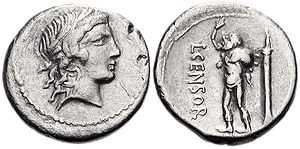Marcius Censorinus
- For others with similar names, see Marcia (gens) and Censorinus (disambiguation).

Marcius Censorinus was a name used by a branch of the plebeian gens Marcia of ancient Rome. The cognomen Censorinus was acquired through Gaius Marcius Rutilus, the first plebeian censor, whose son used it. The gens Marcia claimed descent from both Ancus Marcius, a king of Rome, and symbolically from Marsyas the satyr, who was associated with free speech and political liberty; see further discussion at Prophecy and free speech at Rome. The Marcii Censorini were consistent populares, supporting Marius, Cinna, Julius Caesar, and Antonius.
Marcii Censorini
- Lucius Marcius Censorinus was curule aedile in 160 BC, praetor by 152, consul in 149, and censor in 147. He was the son of a Gaius Marcius Censorinus.
- Gnaeus Marcius Censorinus was a tribune of the plebs in 122 BC.
- Gaius Marcius Censorinus was a moneyer (monetalis) ca. 88 BC. In 87, as a military tribune or prefect, he commanded the cavalry that attacked and killed the consul Gnaeus Octavius, then brought his head to Cinna; the historian Appian remarks[1] that this was the first time a consul's head was displayed on the Rostra, but unfortunately not the last. In 82, near the end of the civil war between Sulla and the Marian-Cinnan faction, Carbo sent Censorinus with eight legions to the aid of the besieged Praeneste, but he was ambushed by Pompeius near Sena Gallica. After Carbo fled to Africa, Censorinus was among the officers who made a last-ditch effort to break Sulla's line that culminated in defeat at the Battle of the Colline Gate.[2]

- Lucius Marcius Censorinus[3] was a moneyer ca. 82 BC, and an officer, perhaps prefect of the fleet, in 70; see also Denarius of L. Censorinus (pictured above).
- Censorinus, a friend of Publius Crassus who died with him fighting at Carrhae, was almost certainly a Marcius.
- Lucius Marcius Censorinus, whose father had the same name, was praetor in 43 BC and a partisan of Marcus Antonius. He was proconsul of the provinces of Macedonia and Achaea 42–40 BC. In 39 BC he was consul with Calvisius Sabinus, and one of the quindecimviri sacris faciundis in 17 BC.
- Gaius Marcius Censorinus was consul in 8 BC. He was proconsul of the province of Asia ca. 3 BC, and was honored as patron and benefactor by the people of Miletus.[4] He died in his province in A.D. 2.[5]
References
Unless otherwise noted, dates, offices and citations of ancient sources are from T.R.S. Broughton, The Magistrates of the Roman Republic (American Philological Association, 1951, 1986), vol. 1; vol. 2 (1952); vol. 3 (1986); abbreviated MRR.
- ↑ Appian, Bellum Civile 1.71.
- ↑ Robin Seager, "Sulla," in The Cambridge Ancient History (Cambridge University Press, 1994), vol. 9, pp. 178 online and 193; Patrick McGushin, Sallust: The Histories (Oxford: Clarendon Press, 1992), vol. 1, p. 101 online.
- ↑ The praenomen is indicated by the coin, but not the gentilicum, which is given for the Censorinus who was an officer and is considered the same man.
- ↑ Claude Eilers, Roman Patrons of Greek Cities (Oxford University Press, 2002), p. 236 online.
- ↑ Josephus, Antiquitates Judaicae 16.165; Velleius Paterculus 2.101; Ronald Syme, "C. Marcius Censorinus in the East," in Anatolica (Oxford: Clarendon Press, 1995), pp. 302–307, limited preview online.